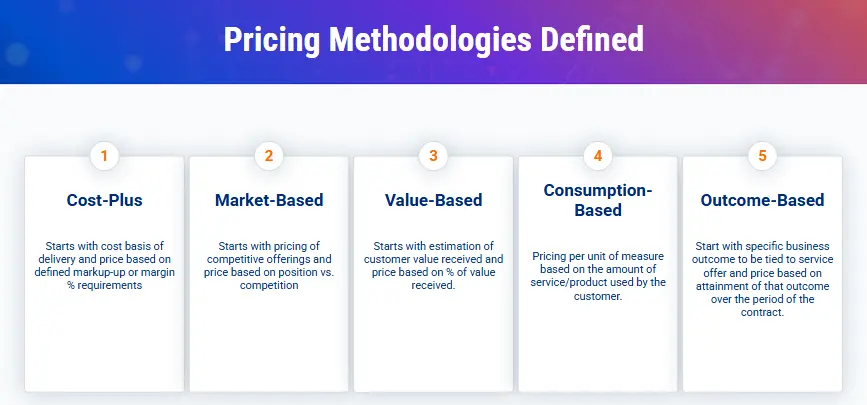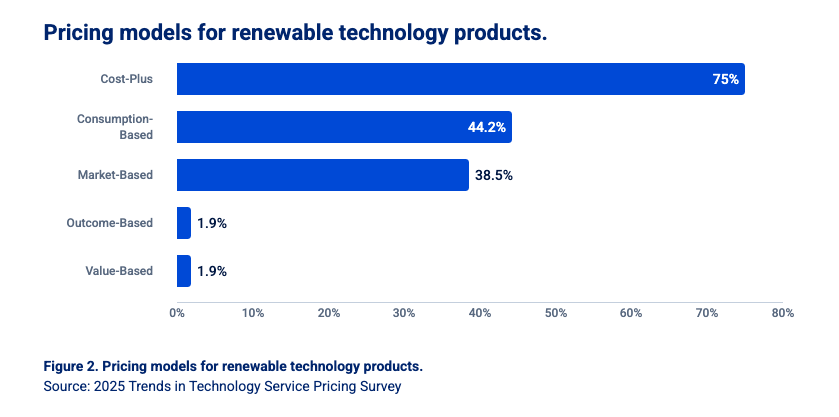Pricing isn’t just a number—it’s a strategy. In the technology industry, many companies are starting to question whether their current pricing models align with how customers perceive and value their offerings. While cost-plus pricing and per-user models remain the norm, an increasing number of organizations are exploring modern approaches, such as consumption-based and value-based pricing, to drive growth and enhance customer outcomes.
Traditional per-user technology pricing models, in particular, are facing challenges as they often fail to reflect actual usage, can hinder widespread technology adoption due to cost concerns, and may misalign price with the actual business value derived from the technology.
If your business is still relying on traditional pricing anchors, it is time to take a closer look. This blog reveals where tech companies are today—and where you need to go next to stay competitive.
Key Takeaways
- Most tech companies still rely on traditional pricing models, but many are starting to explore forward-thinking strategies.
- The biggest roadblocks to adopting value-based pricing are accurately measuring outcomes and effectively communicating value to customers.
- Without evolving your pricing model, you risk stalled growth, higher churn, and a weaker connection to the value you provide.

Traditional Pricing Still Dominates—But It's Losing Effectiveness
Despite ongoing shifts in customer expectations and advances in technology, the cost-plus pricing methodology remains the dominant model for service offers. Many companies also continue to rely on per-user price anchors for their technology products. If you're in that camp, you're not alone—but you might not be fully aligned with where the industry is heading.

Why does this matter? Because traditional pricing methods often fail to reflect the actual value your services deliver. As customers grow more sophisticated and AI continues to reshape business models, pricing that’s disconnected from outcomes puts you at risk of falling behind.
Related: The State of Technology Services Pricing
Forward-Thinking Pricing Models Are Gaining Traction
You may already be hearing about value-based or consumption-based (usage-based) pricing models. These forward-thinking approaches are gaining interest—and for good reason. They can align pricing more closely to the actual value your customers receive or the volume of service they use, which makes it easier to:
- Build trust with your customers.
- Align pricing with customer success.
- Reduce churn and improve retention.
However, TSIA’s survey found that while a significant portion of companies is transitioning towards forward-thinking models like value-based or consumption-based pricing, many are still not actively considering a change. If your organization hasn’t yet begun exploring modern pricing strategies, you may be missing a significant opportunity to differentiate yourself from competitors.
Related: The Slow Transition to Value-Based Offer Pricing
What’s Standing in the Way of Pricing Evolution?
So, what’s holding companies back from evolving their pricing strategies? The data points to a few significant hurdles.
Measuring Tangible Customer Outcomes
You can’t price based on value if you don’t know how much value you’re delivering. For many companies, that’s the core issue. Measuring the specific outcomes your customers achieve with your product or service requires effort—and often, a new mindset.
This is especially true for service offers, where business value is harder to quantify. If you're struggling to capture this data, you're not alone—but it's a gap that needs to be addressed if you want to move toward value-based pricing.
Communicating Value to Customers
Even if you’re delivering strong outcomes, you have to be able to prove it. Clear, consistent communication about the business results your services enable is essential. Without it, pricing based on value just doesn’t land.
If your teams aren’t equipped with the correct language, metrics, or tools to demonstrate value, it will be challenging to convince customers that a different pricing model is worthwhile.
Discounting Practices Point to Inconsistent Pricing Governance
Another red flag? Inconsistent discounting. TSIA’s survey reveals that many companies lack robust discounting governance for everyday use cases. Without structure, discounting becomes subjective, and that can erode both your pricing integrity and customer trust. This might be a good time to ask yourself:
- Do we have defined pricing policies?
- Are we enabling our sales teams with clear discounting guidelines?
- Are we tracking how those discounts affect profitability and customer perception?
Who Owns Pricing Strategy—and Why That Matters
TSIA’s research found that ownership of pricing strategy varies widely. In many organizations, pricing decisions are typically made by the CEO or executive team. Others place pricing responsibilities with service offer management. And surprisingly, a significant number of companies have no central pricing design function at all.
If your pricing strategy feels inconsistent, disjointed, or reactive, it's essential to take a closer look at the pricing ownership. Without a centralized approach, it’s challenging to design pricing that supports both customer success and long-term business goals.
Related: TSIA Offer Pricing Continuum and Its Challenges

Value-Based Pricing Requires a Mindset Shift
Transitioning to value-based pricing isn’t just about updating your rate card—it’s about rethinking how you define and deliver value. This shift touches every part of your organization, from product design to customer success to sales enablement. To move forward, you’ll need to:
- Build capabilities to measure customer outcomes.
- Equip your teams to articulate value.
- Align internal stakeholders around a shared pricing strategy.
- Develop pricing policies that scale.
It’s not a quick fix, but it’s becoming a business imperative.
Don’t Let Outdated Pricing Hold You Back
If you're still relying on cost-plus or per-user pricing, it's time to ask whether that approach is serving your business—or holding it back. TSIA’s research shows that while traditional models remain common, they’re increasingly misaligned with how customers measure success and value.
To stay competitive, you need a pricing strategy that reflects what your customers care about most: outcomes. That means shifting your focus from the cost of your offer to what it’s worth. And that shift starts with you.
Whether you’re just beginning to explore forward-thinking models or already on the path to value-based pricing, investing in the right capabilities, policies, and leadership can help you create stronger pricing strategies that support growth, retention, and long-term success.

FAQs
What is value-based pricing in technology services?
Value-based pricing involves setting prices based on the business value your customers realize from using your product or service, rather than basing prices on supplier costs or market comparisons. It aligns your charges with the operational impact you deliver.
Why is measuring customer value realization so difficult?
Many companies lack the tools or frameworks to track customer results after implementation. Without clear success metrics or a system for capturing them, it’s hard to quantify value—and even harder to price around it.
How can TSIA Intelligence and the Performance Optimizer help?
TSIA Intelligence provides real-time insights into pricing trends, adoption patterns, and industry benchmarks. Performance Optimizer helps you evaluate your organization’s pricing capabilities and practices, enabling you to identify gaps and develop a stronger pricing strategy.
Smart Tip: Embrace Data-Driven Decision Making
Making smart, informed decisions is more crucial than ever. Leveraging TSIA’s in-depth insights and data-driven frameworks can help you navigate industry shifts confidently. Remember, in a world driven by artificial intelligence and digital transformation, the key to sustained success lies in making strategic decisions informed by reliable data, ensuring your role as a leader in your industry.













